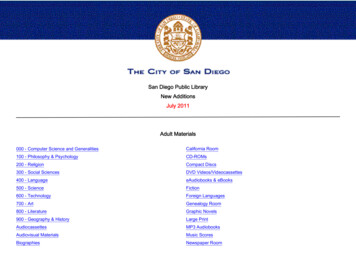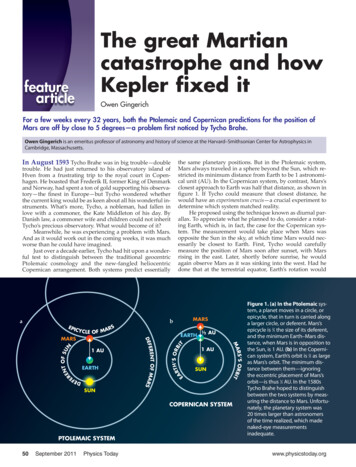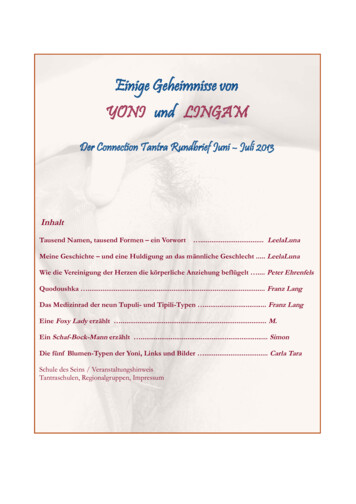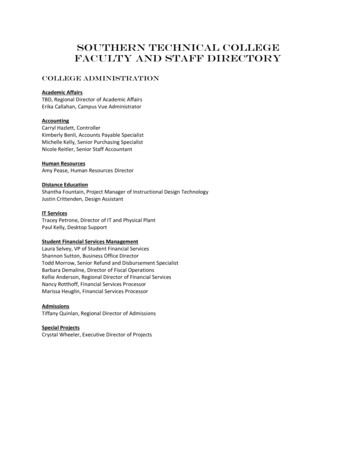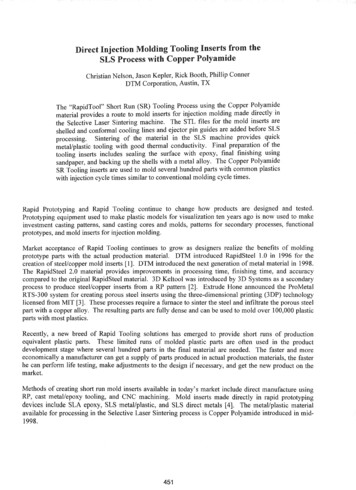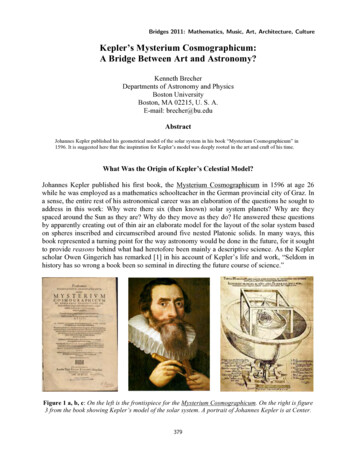
Transcription
Bridges 2011: Mathematics, Music, Art, Architecture, CultureKepler’s Mysterium Cosmographicum:A Bridge Between Art and Astronomy?Kenneth BrecherDepartments of Astronomy and PhysicsBoston UniversityBoston, MA 02215, U. S. A.E-mail: brecher@bu.eduAbstractJohannes Kepler published his geometrical model of the solar system in his book “Mysterium Cosmographicum” in1596. It is suggested here that the inspiration for Kepler’s model was deeply rooted in the art and craft of his time.What Was the Origin of Kepler’s Celestial Model?Johannes Kepler published his first book, the Mysterium Cosmographicum in 1596 at age 26while he was employed as a mathematics schoolteacher in the German provincial city of Graz. Ina sense, the entire rest of his astronomical career was an elaboration of the questions he sought toaddress in this work: Why were there six (then known) solar system planets? Why are theyspaced around the Sun as they are? Why do they move as they do? He answered these questionsby apparently creating out of thin air an elaborate model for the layout of the solar system basedon spheres inscribed and circumscribed around five nested Platonic solids. In many ways, thisbook represented a turning point for the way astronomy would be done in the future, for it soughtto provide reasons behind what had heretofore been mainly a descriptive science. As the Keplerscholar Owen Gingerich has remarked [1] in his account of Kepler’s life and work, “Seldom inhistory has so wrong a book been so seminal in directing the future course of science.”Figure 1 a, b, c: On the left is the frontispiece for the Mysterium Cosmographicum. On the right is figure3 from the book showing Kepler’s model of the solar system. A portrait of Johannes Kepler is at Center.379
BrecherQuestion: What actually was the origin of Kepler’s Celestial Model? That is, what led him topropose a three dimensional model based on nested Platonic solids to explain the mainly twodimensional planetary orbital motions? More specifically, what was the inspiration for themodel? Was it astronomical observations (by Tycho or Copernicus)? Or was it physicalreasoning (by Kepler as the first physicist)? Or perhaps mathematical analogies (geometry,symmetry)? Or did it spring from another intellectual domain?Origin of the Model As Reported by Kepler“Thus it happened 19 July 1595, as I was showing in my class how the great conjunctions (ofSaturn and Jupiter) occur successively eight zodiacal signs later, and how they gradually passfrom one trine {an angle of 120 degrees - KB} to the another, that I inscribed within a circlemany triangles, or quasi triangles, such that the end of one was the beginning of the next. In thismanner a smaller circle was outlined by the points where the lines of the triangles crossed eachother And then again it struck me: why have plane figures among three-dimensional orbits?Behold, reader, the invention and whole substance of this little book! In memory of the event, Iam writing for you the sentence in the words of that moment of conception: The earth’s orbit isthe measure of all things; circumscribed around it is a dodecahedron, and the circle containingthis will be Mars; circumscribed around Mars a tetrahedron, and the circle containing this will beJupiter; {and so on - KB}. You now have the reason for the number of planets.”Response of Kepler ScholarsIn the succeeding 400 years of Kepler scholarship, most Kepler scholars, including OwenGingerich [1] and Max Caspar [2] - author of the definitive Kepler biography - seem to havetaken Kepler at his word. J.V. Field in Kepler’s Geometrical Cosmology [3] wrote: “We surelymust accept Kepler’s account Whether Kepler had somewhere read something which somehowsuggested the theory to him without his being aware of the source is a speculation the presentwriter is content to leave to others. It seems rather perverse to doubt Kepler’s straightforwardaccount of how he came to his theory.” Is Kepler’s account really how he went fromto?Figure 2 a, b: On the left is the diagram from the Mysterium Cosmographicum showing the twodimensional overlapping triangles discussed by Kepler. On the right is his three dimensional model.380
Kepler’s Mysterium Cosmographicum: A Bridge Between Art and Astronomy?An Alternative HypothesisIt is suggested here that Kepler’s model using five nested Platonic solids was a direct outgrowthof 16th century studies of perspective and of the art and craft of that time. Specifically, it seemspossible – even likely - that Kepler was inspired (either consciously or unconsciously) by thenwell-known paintings, engravings, books and - perhaps most directly - magnificent andmemorable three-dimensional sculptures of nested regular polyhedra made on “ornamentalturning” engines. These elaborate wood and ivory sculptures could be found in“Wunderkammers”, the forerunners of today’s art and science museums. Frederick I, Duke ofWürttemberg and Rudolf II - Kepler’s first and second patrons - had such collections.Figure 3: Detail from the painting “Cabinet of Curiosities” by Domenico Remps, in the Opificio dellePietre Dure, Florence. Though painted in the 1690’s, it illustrates the style of renaissance Kunstkammers.Art, Perspective, Geometry and Platonic Solids Throughout the 15th CenturyWhat follows is a very brief review of some of the artistic and mathematical currents thatflourished beginning in the early 15th century in Italy. (For a detailed discussion, see Kemp’smasterful study [4].) These developments partially sprang from attempts to develop a rigoroustheory of perspective, but also from the re-introduction in Europe of the Greek knowledge ofgeometry and polyhedra. These techniques and ideas evolved primarily in Florence, Italybeginning with the famous perspective experiment by Filippo Brunelleschi in 1425. They werefurther developed by Leon Battista Alberti, Luca Pacioli, Piero della Francesca and Leonardo DaVinci. How did their original ideas of perspective and three-dimensional geometry get from Italyto Germany in the early 16th century? Partly as a result of Durer’s two visits to Italy to learnabout perspective, and through his subsequent text Four Books on Measurement (published inNuremberg in 1525). The book presented a discussion of how to render pictures with correctperspective. It contained several images of perspective renderings using mechanical and opticaldevices (see Figure 4). The fourth book explored regular polyhedra, including the Platonic solids.It has been reported that Kepler owned a copy of this book. In any case, at some point he haddefinitely seen a copy since he wrote about errors contained within it.381
BrecherFigure 4: Woodcut by Albrecht Durer from his book on perspective Underweysung der Messungpublished in Nuremberg in 1525. The size of the image in the book is almost exactly as presented here.Ideas of Perspective and Polyhedra Spread Throughout All of Europe, Including GermanyHow far did these ideas penetrate German intellectual culture in the following years? The answeris quite deeply. These ideas - developed in the realm of painting - were used by artisans workingin wood, gold, silver, as well as in ivory and other media. They were then presented in books –partly as working manuals for artisans. Several examples of pages from these are shown below.Figure 5 a, b: On the left is the cover of the book Livre de Perspective by Jehan Cousin (1560). On theright is a page from the book Geometria et Perspectiva by Lorenz Stoer (1567).382
Kepler’s Mysterium Cosmographicum: A Bridge Between Art and Astronomy?The cover of the Cousin book (Figure 5a) illustrates ideas of perspective and displays the fivePlatonic solids. Lorenz Stoer (Figure 5b) explicitly incorporated nested solids. Many such bookswere published during the 16th century and were included in the libraries of the nobilitythroughout Germany. Notice the similarity in the style of the artwork in several of these imageswith that displayed in Figure 3 of the Mysterium Cosmographicum. Though this may only showthat the engraver was familiar with these images, it seems plausible that Kepler was as well.Figure 6 a, b: On the left is a page from the book Perspectiva Corporum Regularum by Wenzel Jamnitzer(1568). On the right is a page from the book La Practica di Prospettiva by Lorenzo Sirigatti (1596).Figure 7 a, b, c: Images of two European wood wall panel intarsia and of a wood inlaid writing desk.383
BrecherKepler’s Model and Ornamental TurningsVarious kinds of lathes have been used to make artistic and utilitarian objects out of wood, ivoryand other materials for at least 2300 years. The first depiction of a lathe in an image is from theEgyptians. Beginning around 1500 AD in Europe, “ornamental turning engines” were devised toproduce astonishingly elaborate objects. An example of such a turning engine from this period isshown below [5] along with ornamental turnings made in Germany between 1560 and 1590 AD.Figure 8 a, b, c: On the left is an engraving of an ornamental turning engine from about 1600 AD. In themiddle and at right are examples of ivory ornamental turnings produced between about 1560 and 1590 ofthe kind that are in the Grünes Gewölbe (Green Vault) museum in Dresden, Germany.The origin of nested ivory ornamental turning in Europe is not settled: Did the idea start in Chinaand migrate to Europe? Or did it originate independently in each society?Figure 9 a, b, c: On the left is an ivory turning made in Dresden by Egidius Lobenigk in 1591. In themiddle is a modern Chinese “Puzzle Ball”. At right is a modern wood turning made by Claude Lethiecq.384
Kepler’s Mysterium Cosmographicum: A Bridge Between Art and Astronomy?The first record [6] of a Chinese “puzzle ball” or “mystery ball” or “dragon ball” – as the modernversions are called – dates to the year 1388 AD. In section XXXVII of the book Ko Ku Yao Lun,the author Ts’ao Chao wrote “I have seen a hollow-centered ivory ball, which has two concentricballs inside it, which can both revolve. It is called “witch ball”. I was told that it was made forthe Palaces of the Sung dynasty.” The ivory ornamental turnings that were made in Europe werealso made by and for the nobility and exchanged between themselves as gifts. However, the firstrecord of such an object in Germany dates from around 1560. Did the Duke of Württemberg Kepler’s patron in his youth and correspondent in 1596 - show him such objects? Kepler’ssecond employer, Rudolf II - Emperor of the Holy Roman Empire - was an enthusiastic turner.Kepler visited his Wunderkammer in 1601 and wrote about it. Did the Duke’s collection of suchobjects encourage Kepler to hold on to his model, even after he found his three laws? Keplernever lost enthusiasm for the model, leading to the re-publication of the Mysterium in 1521.Further Remarks About Kepler’s Model and Ornamental TurningsFigure 10, a b, c: On the left is a figure from Jamitzer’s Perspectiva; in the middle, the inner part ofKepler’s model; on the right, an ivory ornamental turning from Dresden made ca. 1590.Images created by Jamnitzer, Stoer and others were used by cabinetmakers, intarsia artisans anddesigners of three-dimensional ornamental turnings (cf. Figures 10 a, b, c). The Duke ofWürttemberg - Kepler’s first patron - had such objects and design books in his home. Kepler and likely his professor from the 1590’s, Michael Maestlin - could have been aware of thesecreations - either having seen them directly or having heard or read of them. Before theMysterium was published, Kepler even asked the Duke to have his model made as a punch bowl!ConclusionTwo-dimensional engravings and three-dimensional models of inscribed regular polyhedra werewell known in Germany in the late 16th century. Kepler had the opportunity to have seen, read orlearned of them from books and models. The style of the Mysterium Plate III engraving is in thestyle of many of these polyhedral engravings. It seems highly likely that Kepler’s model of thesolar system had direct antecedents in the arts, crafts, engravings and sculptures of his day.385
BrecherAfterwordKepler’s nested polyhedral model of the cosmos presented in the Mysterium Cosmographicum in1596 may well have been inspired by 16th century ornamental turnings, either directly orindirectly. If this is the case, then the 16th century ornamental turning engine could alsoreasonably be called the “Lathe of Heaven”.AcknowledgementsThere are perhaps a few dozen ornamental wood turners who are currently making magnificentpolyhedral sculptures – many based on the Platonic solids and other geometrical forms. I wouldlike to thank three of them for sharing their insights and wonderful creations with me: RandyRhine, Bob Rollings and Claude Lethiecq.Randy RhineClaude LethiecqBob RollingsThis work has been supported in part by NSF Grant # DUE – 0715975 for “Project LITE: LightInquiry Through Experiments”.References[1] O. Gingerich, “Johannes Kepler”, Dictionary of Scientific Biography, (New York, Scribner, 1979).[2] M. Caspar, Kepler, (New York, Dover Publications, 1993).[3] J. V. Field, Kepler’s Geometrical Cosmology, (Chicago, The University of Chicago Press, 1988).[4] M. Kemp, The Science of Art, (New Haven, Yale University Press, 1990).[5] K. Maurice, Sovereigns as Turners, (Zurich, Verlag Ineichen, 1985).[6] P. David (translator), Chinese Connoisseurship: The Ko Ku Yao Lun, (New York, Praeger, 1971).PostscriptKepler’s nested polyhedral model of the cosmos tried to account for the relative spacing of theplanetary orbits in our Solar System. This was an early attempt at a Titius-Bode “Law” ofplanetary distances. It would be fitting if Kepler (the NASA planet hunting satellite named forthe great astronomer) leads to the discovery of more extra-solar planetary systems that showsimple mathematical regularities in the spacing of planets around their central stars, perhapssome day leading to a definitive “Fourth” (or “Zeroth”) Kepler Law. It would provide awonderful example of a bridge between renaissance art, mathematics and modern science.386
The first record [6] of a Chinese "puzzle ball" or "mystery ball" or "dragon ball" - as the modern versions are called - dates to the year 1388 AD. In section XXXVII of the book Ko Ku Yao Lun, the author Ts'ao Chao wrote "I have seen a hollow-centered ivory ball, which has two concentric balls inside it, which can both revolve.
